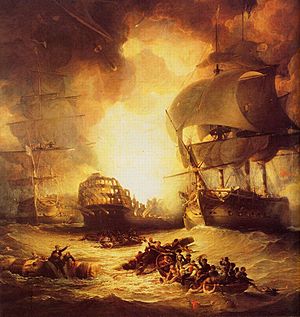Battle of the Nile facts for kids
The Battle of the Nile was a very important naval (sea) battle fought between the British and French navies. It took place from August 1 to 3, 1798. The British Royal Navy, led by Horatio Nelson, won a big victory over the French fleet, which was supporting Napoleon Bonaparte's army. The battle happened in a bay near the River Nile in Egypt, which is why it's called the Battle of the Nile. This victory gave Britain control of the eastern Mediterranean. It also trapped Napoleon's army in Egypt, cutting them off from France.
Contents
What Was the Battle of the Nile?
The Battle of the Nile was a major sea fight during the French Revolutionary Wars. It was part of Napoleon Bonaparte's plan to invade Egypt and threaten British trade routes to India. The battle was a surprise attack by the British fleet on the French ships anchored in Aboukir Bay.
Who Fought in the Battle?
The main leaders in this battle were:
- For the British: Horatio Nelson, a famous and skilled admiral. He led the British Royal Navy fleet.
- For the French: Vice-Admiral François-Paul Brueys d'Aigalliers. He commanded the French fleet. Napoleon Bonaparte was leading the French army on land.
Nelson's fleet had 14 ships, while the French had 13. The French ships were anchored in a line, hoping to defend themselves easily.
Where Did the Battle Happen?
The battle took place in Aboukir Bay, near the mouth of the Nile River in Egypt. The French fleet was anchored close to the shore, believing they were safe. However, Nelson found a way to attack them from both sides. This was a very clever and risky move.
Why Was This Battle Important?
The Battle of the Nile was a huge victory for the British and had many important effects:
- British Control of the Mediterranean: The victory gave Britain strong control over the eastern Mediterranean Sea. This was important for trade and military movements.
- Napoleon's Army Trapped: Napoleon's army, which had just won the Battle of the Pyramids, was now cut off from France. The French navy was destroyed, so they couldn't get supplies or reinforcements. This made it very hard for Napoleon to continue his campaign in Egypt.
- Boost for Britain: The win greatly boosted British morale and showed their naval power. It also encouraged other European countries to join forces against France.
- Nelson's Fame: Horatio Nelson became an even greater hero in Britain after this battle.
What Happened After the Battle?
After the battle, Napoleon's army was stuck in Egypt. They fought on for some time, but without naval support, their situation was hopeless. Eventually, the French army in Egypt surrendered at the Capitulation of Alexandria in 1801. The Battle of the Nile was a key moment that changed the course of the French Revolutionary Wars and showed the importance of sea power.
Images for kids
-
Rear-Admiral Sir Horatio Nelson, Lemuel Francis Abbott, 1800, National Maritime Museum. Visible on his cocked hat is the aigrette presented by the Ottoman Sultan as a reward for the victory at the Nile
-
François-Paul Brueys d'Aigalliers artist unknown, Palace of Versailles
-
Battle of the Nile, Augt 1st 1798, Thomas Whitcombe, 1816, National Maritime Museum. The British fleet bears down on the French line.
-
The Battle of the Nile, 1 August 1798, Nicholas Pocock, 1808, National Maritime Museum
-
Tonnant under fire from HMS Majestic at the Battle of the Nile.
-
The Battle of the Nile, Thomas Luny, 1830, National Maritime Museum
-
Battle of the Nile, 1 August 1798, Daniel Orme, 1805, National Maritime Museum. Nelson returns on deck after his wound is dressed.
-
A 1799 depiction of the Battle of the Nile by Thomas Whitcombe. Orient is on fire, and visible under her stern, and drifting clear of the burning ship, is the dismasted Bellerophon.
-
The Battle of the Nile: Destruction of 'L'Orient', 1 August 1798, Mather Brown, 1825, National Maritime Museum
-
Battle of the Nile, Thomas Luny, 1834
-
Battle of the Nile, Augt 1st 1798, Thomas Whitcombe, 1816, National Maritime Museum – the climax of the battle, as Orient explodes
-
A True Position of the French fleet as they were moored near the Mouth of the Nile and the manner in which Lord Nelson formed his attack on them, Robert Dodd, 1800, National Maritime Museum
-
The Gallant Nellson bringing home two Uncommon fierce French Crocadiles from the Nile as a Present to the King, James Gillray, 1798, National Maritime Museum. The crocodiles represent Fox and Sheridan.
See also
 In Spanish: Batalla del Nilo para niños
In Spanish: Batalla del Nilo para niños



















